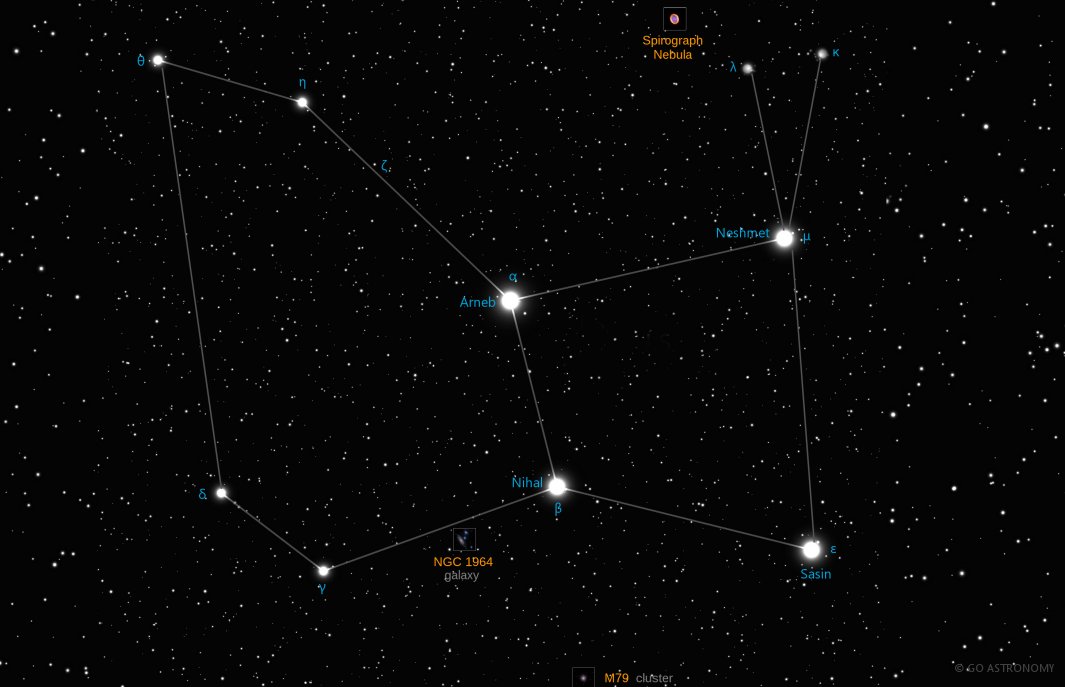Lepus, the Hare (Lep)
(LEP-us)
The Southern constellation of Lepus, the Hare, is best viewed in Winter during the month of February.
Lepus is the 51st largest constellation. It's brightest star is Ameb at magnitude 2.58. The boundary of the Lepus constellation contains 5 stars that host known exoplanets.
- Pronunciation:
- LEP-us
- Meaning:
- Hare
- Genitive:
- Leporis
- Abbreviation:
- Lep
- Constellation Family:
- Orion
- Hemisphere:
- Southern
- Quadrant:
- SQ1
- Visibility:
- 63° N - 90° S
- Best viewing month*:
- February
- Area:
- 290 sq. degrees
- Size:
- 51st largest
- Right Ascension (avg):
- 5h 26m
- Declination (avg):
- -19°
- Brightest star:
- Ameb (2.58)
- Stars with planets:
- 5
- Caldwell objects:
- |
Brightest Stars in Lepus
The 10 brightest stars in the constellation Lepus by magnitude.
- Star
- Magnitude
- Spectral class
- Alpha Leporis (α Lep)
- 2.58
- F0Ib
- Beta Leporis (β Lep)
- 2.81
- G5II
- Epsilon Leporis (ε Lep)
- 3.19
- K4III
- Mu Leporis (μ Lep)
- 3.29
- B9IV HgMn
- Zeta Leporis (ζ Lep)
- 3.55
- A2Vann
- Gamma Leporis (γ Lep)
- 3.59
- F7V
- Eta Leporis (η Lep)
- 3.71
- F1V
- Delta Leporis (δ Lep)
- 3.76
- G8III/IV
- Lambda Leporis (λ Lep)
- 4.29
- B0.5IV
- Kappa Leporis (κ Lep)
- 4.36
- B7V
Double Stars in Lepus
These are the brightest and easiest-to-find double, triple, and quadruple star systems in the constellation Lepus. Also see all star clusters.
- Star system
- Magnitudes
- Type
- Gamma Leporis
- 3.6, 6.3
- double
Star Clusters in Lepus
The most notable and easy-to-find star clusters in the constellation Lepus . Also see all star clusters.
Nebulae in Lepus
Notable and easy-to-find nebulae in the constellation Lepus . Also see all nebulae.
Galaxies in Lepus
The most notable galaxies in the constellation Lepus. Also see all galaxies.
The Hare Constellation
Lepus, Latin for "hare", is a constellation in the southern celestial hemisphere. This constellation, while not large, is known for its rich array of stars and deep-sky objects. It also holds a special place in ancient mythology.
Historical Overview
The constellation Lepus has been recognized since antiquity, with its roots in ancient Greek astronomy. In the sky, it is located just beneath Orion, the hunter, which has led to the myth that Lepus represents a hare being hunted by Orion. This association with Orion has remained consistent through the centuries, with Lepus appearing just south of Orion in our modern night sky.
Location and Main Features
Lepus is located in the second quadrant of the southern hemisphere (SQ2) and can be seen at latitudes between +63? and -90?. It is surrounded by eight different constellations, including Orion to the north, Monoceros to the east, and Eridanus to the west. With an area of 290 square degrees, Lepus is the 51st largest constellation in our sky.
Major Stars
The constellation Lepus hosts several notable stars. Its brightest star, Arneb (Alpha Leporis), is a supergiant star approximately 2,200 light-years away from us with a magnitude of 2.6, making it a standout in the constellation. The name Arneb comes from the Arabic for "hare".
Beta Leporis, also known as Nihal, is the second brightest star in Lepus. It's a giant star located approximately 159 light-years away, with a magnitude of 2.8. Gamma Leporis is a binary star, approximately 29 light-years away, consisting of an F-type main-sequence star and an orange dwarf.
Deep Sky Objects
One of the most notable deep sky objects within Lepus is Messier 79 (M79), a globular cluster located about 41,000 light-years away. It was discovered by Pierre M?chain in 1780 and subsequently included in Charles Messier's catalogue. With an apparent magnitude of 7.7, it is quite faint and requires a telescope to observe.
Furthermore, the constellation also includes a number of galaxies such as IC 418, a planetary nebula known as the "Spirograph Nebula" due to its intricate pattern, reminiscent of designs made by a spirograph.
Observation
Lepus is best viewed in the winter months in the northern hemisphere. It's easily located due to its proximity to Orion, one of the most recognizable constellations. A pair of binoculars or a small telescope would enhance the viewing experience, particularly for spotting deep-sky objects like M79.
Lepus in Modern Astronomy
Today, Lepus continues to be of interest to astronomers for its variety of celestial objects. Amateur astronomers often challenge themselves to find and observe the deep-sky objects within Lepus, while professional astronomers study these same objects to learn more about the universe. The stars of Lepus, especially its binary systems, also provide valuable information for research into stellar evolution.
While Lepus may be a small and often overlooked constellation, it offers astronomers a wealth of stars and deep-sky objects to explore, as well as a rich connection to our astronomical past.
* Constellation shown for northen hemisphere skies. For the southern hemisphere, constellations appear rotated 180 degrees (upside-down and left-right reversed) from what is shown. Remember that seasons are reversed too - summer in northern latitudes is winter in southern latitudes.
** Circumpolar constellations are visible year-round in the hemisphere listed (and not at all in the opposite hemisphere).





